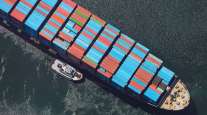ATA's Bob Costello: Economy to Stay Weak
This story appears in the June 13 print edition of Transport Topics.
Trucking should expect a generally weak economy in 2016, though the long-standing inventory glut should ease in a few months to make the freight market feel better than today’s uninspiring conditions, American Trucking Associations Chief Economist Bob Costello said.
Gross domestic product should grow 1.9% overall and “improve from where we have been in the first quarter [0.8%],” he said in a June 8 webinar, with 2.5% average growth over the next three quarters. That’s below last year’s 2.4% GDP growth, Costello’s late December forecast for 2.6% or higher growth this year and his forecast for 2.7% improvement in 2017.
 Costello
CostelloCostello cited long-standing concern about inventories. Shippers were prompted to add inventory after a strong 2014 for trucking that squeezed capacity and drove up rates, he said. West Coast port delays compounded the situation, along with the rise of e-commerce and smaller distribution centers closer to consumers.
“By the end of the third quarter and early fall, this [inventory surplus] should be over,” he said. “That’s when freight will feel better.”
Costello noted that truckload, which generates 95% of for-hire freight, has seen shipments drop 2% year-over-year since June. Weaker dry van business drove the decline, though smaller sectors such as flatbed and refrigerated have posted some increases.
Art Hatfield, a Raymond James analyst, agreed with Costello.
“Transportation volumes continue to be soft,” Hatfield wrote last week. “While there has been some positive commentary in select pockets of the transportation complex in the second quarter, it has been sporadic and likely does not offer much hope for a meaningful near-term inflection.”
“The truckload market has been very challenging,” Swift Transportation Co. President Richard Stocking said on an early June analyst call. “April was weak, May was a bit better and June will be a bit stronger.”
With less freight available, the Phoenix-based company that ranks No. 6 on the Transport Topics Top 100 list of the largest U.S. and Canadian for-hire carriers is using the spot market more to fill trucks.
Other recent market indicators included regulatory filings from No. 12 ArcBest Corp. and No. 11 Old Dominion Freight Line. ArcBest reported weaker less-than-truckload tonnage, while Old Dominion said tonnage rose slightly.
On the economic front, Costello continues to see consumer demand, helped by wage growth, and the housing market as positive forces that will aid trucking. The 20% increase in housing starts between 2014 and 2016, including a recent shift toward more single-family dwellings, is helping dry van and flatbed fleets alike as builders and buyers require materials to construct and stock homes.
The housing recovery “is sustainable going forward in terms of the economy and in terms of freight,” Costello said.
The manufacturing sector has improved for three consecutive months but still isn’t strong. Costello sought to dispel notions that weak manufacturing data in recent months is predicting a recession, noting that his review of manufacturing trends since 1950 has predicted 24 recessions, but only 10 actually happened.
With the strong dollar, manufacturers that specialize in exports “are really struggling,” while producers for domestic markets “are doing better but not great.”
The energy sector also remains weak as crude prices remain low despite recent increases.
Costello noted that energy production has dropped just 6% since a peak late in 2014, but trucking has been hurt far more by a 43% drop in exploration that required water, sand and chemicals shipments.
“It is not energy production that drives freight,” he said. “It’s the number of new wells we drill, and that freight has essentially gone away.”
Costello’s equipment outlook was mixed.
Truck makers should prepare for continued market weakness because buyers need both the ability and the willingness to purchase new equipment. Fleets generally don’t have either now because of cash squeezed by flattening freight rates and lower used truck prices. At the same time, weaker freight volume and the driver shortage are restricting the need to buy more trucks, he added.
On the other hand, trailer manufacturers are doing better, and should continue to do so, because of demand, particularly from smaller fleets, to add equipment that can be placed for shippers to load while drivers can keep rolling.




